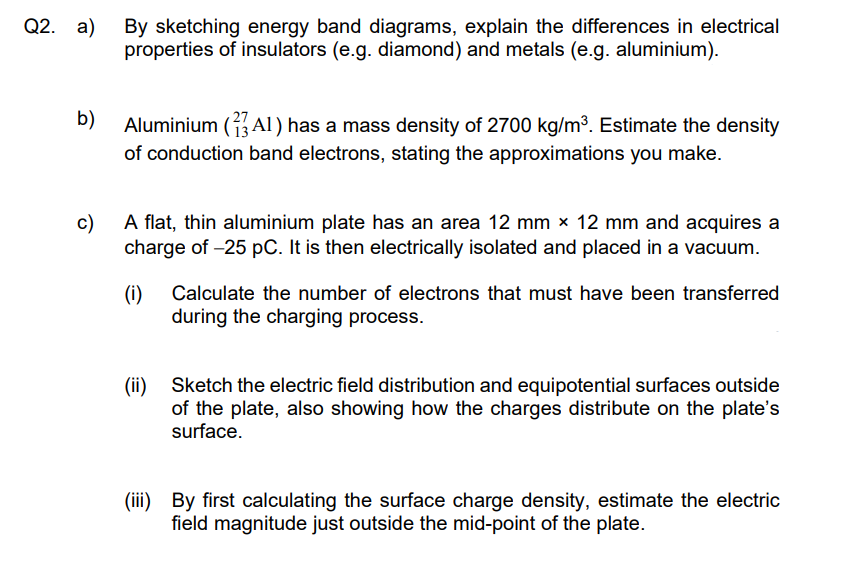Q2. a) b) By sketching energy band diagrams, explain the differences in electrical properties of insulators (e.g. diamond) and metals (e.g. aluminium). Aluminium (AI) has a mass density of 2700 kg/m³. Estimate the density of conduction band electrons, stating the approximations you make. c) A flat, thin aluminium plate has an area 12 mm × 12 mm and acquires a charge of -25 pC. It is then electrically isolated and placed in a vacuum. (i) Calculate the number of electrons that must have been transferred during the charging process. (ii) Sketch the electric field distribution and equipotential surfaces outside of the plate, also showing how the charges distribute on the plate's surface. (iii) By first calculating the surface charge density, estimate the electric field magnitude just outside the mid-point of the plate.
Q2. a) b) By sketching energy band diagrams, explain the differences in electrical properties of insulators (e.g. diamond) and metals (e.g. aluminium). Aluminium (AI) has a mass density of 2700 kg/m³. Estimate the density of conduction band electrons, stating the approximations you make. c) A flat, thin aluminium plate has an area 12 mm × 12 mm and acquires a charge of -25 pC. It is then electrically isolated and placed in a vacuum. (i) Calculate the number of electrons that must have been transferred during the charging process. (ii) Sketch the electric field distribution and equipotential surfaces outside of the plate, also showing how the charges distribute on the plate's surface. (iii) By first calculating the surface charge density, estimate the electric field magnitude just outside the mid-point of the plate.
Introductory Circuit Analysis (13th Edition)
13th Edition
ISBN:9780133923605
Author:Robert L. Boylestad
Publisher:Robert L. Boylestad
Chapter1: Introduction
Section: Chapter Questions
Problem 1P: Visit your local library (at school or home) and describe the extent to which it provides literature...
Related questions
Question
Q2 parts a and b

Transcribed Image Text:Q2. a)
b)
By sketching energy band diagrams, explain the differences in electrical
properties of insulators (e.g. diamond) and metals (e.g. aluminium).
Aluminium (AI) has a mass density of 2700 kg/m³. Estimate the density
of conduction band electrons, stating the approximations you make.
c)
A flat, thin aluminium plate has an area 12 mm × 12 mm and acquires a
charge of -25 pC. It is then electrically isolated and placed in a vacuum.
(i) Calculate the number of electrons that must have been transferred
during the charging process.
(ii) Sketch the electric field distribution and equipotential surfaces outside
of the plate, also showing how the charges distribute on the plate's
surface.
(iii) By first calculating the surface charge density, estimate the electric
field magnitude just outside the mid-point of the plate.
Expert Solution
This question has been solved!
Explore an expertly crafted, step-by-step solution for a thorough understanding of key concepts.
Step by step
Solved in 2 steps with 1 images

Knowledge Booster
Learn more about
Need a deep-dive on the concept behind this application? Look no further. Learn more about this topic, electrical-engineering and related others by exploring similar questions and additional content below.Recommended textbooks for you

Introductory Circuit Analysis (13th Edition)
Electrical Engineering
ISBN:
9780133923605
Author:
Robert L. Boylestad
Publisher:
PEARSON

Delmar's Standard Textbook Of Electricity
Electrical Engineering
ISBN:
9781337900348
Author:
Stephen L. Herman
Publisher:
Cengage Learning

Programmable Logic Controllers
Electrical Engineering
ISBN:
9780073373843
Author:
Frank D. Petruzella
Publisher:
McGraw-Hill Education

Introductory Circuit Analysis (13th Edition)
Electrical Engineering
ISBN:
9780133923605
Author:
Robert L. Boylestad
Publisher:
PEARSON

Delmar's Standard Textbook Of Electricity
Electrical Engineering
ISBN:
9781337900348
Author:
Stephen L. Herman
Publisher:
Cengage Learning

Programmable Logic Controllers
Electrical Engineering
ISBN:
9780073373843
Author:
Frank D. Petruzella
Publisher:
McGraw-Hill Education

Fundamentals of Electric Circuits
Electrical Engineering
ISBN:
9780078028229
Author:
Charles K Alexander, Matthew Sadiku
Publisher:
McGraw-Hill Education

Electric Circuits. (11th Edition)
Electrical Engineering
ISBN:
9780134746968
Author:
James W. Nilsson, Susan Riedel
Publisher:
PEARSON

Engineering Electromagnetics
Electrical Engineering
ISBN:
9780078028151
Author:
Hayt, William H. (william Hart), Jr, BUCK, John A.
Publisher:
Mcgraw-hill Education,